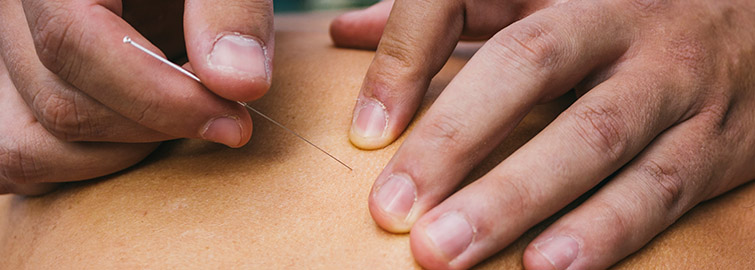
Dry Needling
What is Dry Needling?
Dry needling is a treatment technique used to treat myofascial pain- pain that is of muscular or fascial origin. It involves the insertion of a fine filament needle (0.25mm diameter, equivalent to the combined thickness of 2-3 human hairs) through the skin into the underlying muscle to target myofascial trigger points- which are commonly referred as “knots” within a muscle.
Myofascial trigger points are defined as palpable nodules (knots) located in tight bands of muscle or fascia, which when compressed may cause local tenderness, referred pain, and a twitch response- and are thought to develop in response to injury, or overload to the muscle.
What is the difference between Dry Needling and Acupuncture?
While dry needling and acupuncture use the same type of needle (and technique for its insertion), this is where the similarities end, with the theories and clinical reasoning behind each being vastly different. Dry needling is based upon anatomical and neurophysiological principles, backed by medical science and research, while acupuncture is a treatment method used in Traditional Chinese Medicine (TCM) based upon concepts from ancient Chinese philosophy.
What is Acupuncture?
In Traditional Chinese Medicine the body is viewed as an energy system in which energy flow (Qi, pronounced as chi) occurs along channels called meridians. Disease, conditions or disorders that occur throughout the body are considered to be imbalances in the body’s energy systems, leading to abnormal function and pain. Acupuncture is a method used to balance the body’s Qi, with placement of the acupuncture needles selected according to the type and state of the disease, and the meridians involved.
How does Dry Needling work, and what should I expect to feel during?
Following a thorough subjective and physical examination, if myofascial pain is suspected, the offending myofascial trigger point/s are located by placing the target muscle on stretch and using a variety of palpation techniques, depending on the muscle and its location, to elicit potential symptoms.
Clinical features may include:
- Focal tenderness within a taut band of muscle
- A local twitch response of the target muscle
- Reproduction of the individuals’ presenting pain
- Referred pain to neighbouring regions
Once located, and diagnosed as being the source of an individuals’ pain, the needle is inserted through the skin and into the underlying muscle, directly into the myofascial trigger point. Often, the insertion and removal of the needle is not even felt (recalling that the needle is the combined thickness of a few human hairs)- at the very most you may feel a very brief stinging sensation. If a twitch response of the target muscle occurs, this is best described as a deep cramping sensation, which may cause mild discomfort that lasts no more than a few seconds. Most patients acknowledge that is more of an unusual feeling, rather than a painful one, given that the “twitch” is an involuntary reflexive response.
Dry needling works via complex electrical and chemical processes that occur within our nervous system. To put it in simple terms, the muscle twitch produced in response to the insertion of the needle is thought to inhibit pain signals produced within our brain and spinal cord, in turn relaxing the muscle, and restoring normal blood flow and function to the muscle.
Is Dry Needling safe?
Dry needling is extremely safe. The treatment area is cleaned thoroughly using an alcohol wipe prior to commencing, while the needles are single use, sterile, and individually packaged. Bleeding or bruising of the treatment area rarely occurs.
What to expect after Dry Needling?
It is normal to expect a mild muscular ache in the region which has been treated, that can last from a few hours up to a couple of days. Some describe feeling as though they have received a mild “cork” (contusion, or bruise) to the muscle.
Will Dry Needling help me?
Dry needling can be an effective treatment technique used to provide symptomatic relief of myofascial pain and tension, which can be present in a wide range of musculoskeletal conditions. Rather than being a stand-alone treatment, dry needling is used as an adjunct to other forms of management, forming a small part of a larger treatment management plan which may include other forms of manual therapy, education, and exercise rehabilitation.
Want to know more? Ask your physiotherapist- all of our physiotherapists have extensive experience in performing dry needling.





